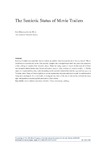Mostrar o rexistro simple do ítem
The semiotic status of movie trailers
| dc.contributor.author | Dornaleteche Ruiz, Jon | es_ES |
| dc.date.accessioned | 2014-10-02T12:32:08Z | |
| dc.date.available | 2014-10-02T12:32:08Z | |
| dc.date.issued | 2012 | es_ES |
| dc.identifier.citation | Culture of communication / Communication of culture, 2012: 1875-1883. ISBN: 978-84-9749-522-6 | es_ES |
| dc.identifier.isbn | 978-84-9749-522-6 | es_ES |
| dc.identifier.uri | http://hdl.handle.net/2183/13487 | |
| dc.description.abstract | [Abstract] Jean Luc Godard once said that “movie trailers are perfect films because the never let you down”. Movie trailers have a crucial role in the film industry. Despite their omnipresence there are just a few academic works willing to explain their semiotic status. There are many types of movie trailers and all of them have singular characteristics (eg: theatrical trailers, teasers, clips, making of, creative trailers…). In this paper, it is explained how they work depending on the semiotic relation between the sign and the object, in Peircean terms. Some of them might have a more metonymic structure and others might be understood as being more analogical. As a conclusion, it is argued why most of the movie trailers have almost the same sign configuration concerning their persuasive effectiveness. | es_ES |
| dc.language.iso | eng | es_ES |
| dc.publisher | Universidade da Coruña | es_ES |
| dc.title | The semiotic status of movie trailers | es_ES |
| dc.type | info:eu-repo/semantics/conferenceObject | es_ES |
| dc.rights.access | info:eu-repo/semantics/openAccess | es_ES |






